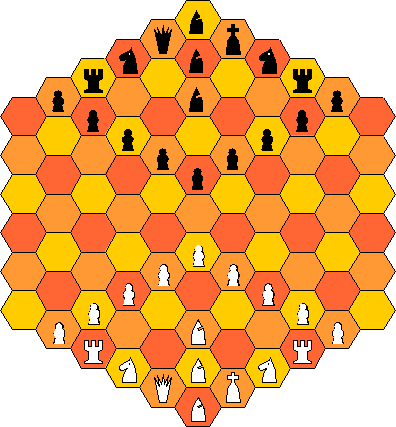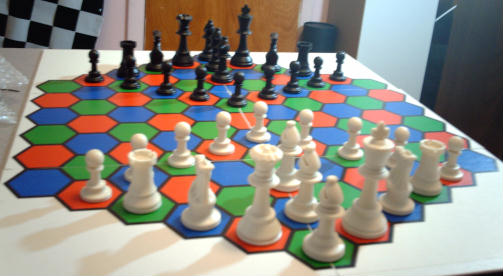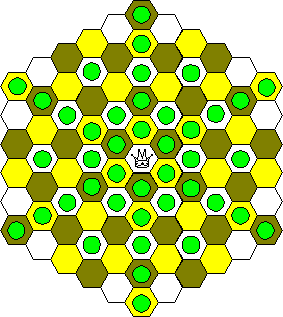Glinski's Hexagonal Chess
Introduction
Over the years a number of variants have been proposed for boards featuring hexagonally shaped cells (commonly called hexes). The most popular of these is Hexagonal Chess which was invented in 1936 by Wladyslaw Glinksi of Poland.David Pritchard tells us, in the Encyclopedia of Chess Variants, that Glinski's game is played by over half-a-million people, mostly in Eastern Europe. Prichard also describes other notable variants such as Dave McCooney's hexagonal chess.
Setup
The board has 91 hexes which incorporate three different colors. It is best if one of the colors is white. The array is as follows:
Note that the array is ordered so that each piece is initially free to move. Also noteworthy is the fact that both the King and Queen defend all three Bishops.
Pieces
The Orthodox Chess pieces (with an extra Bishop and Pawn for each player) are used. "Hex pieces" move differently than those of Orthodox Chess, but their moves are arguably similar.Hexagonal Chess somewhat strains the familiar concepts of orthogonal and diagonal moves. For the purpose of this writing, these terms will assume the following meanings:
orthogonal move - A move wherein a line piece exits one hex and enters another by crossing a common border. Orthogonal moves are never colorbound.
diagonal move - A move wherein a line piece exits one hex and enters another by following the line which connects their nearest corners.* Diagonal moves are always colorbound.
*This move is not incumbered by pieces lying to the right or the left of the thin line of travel. Pieces crowding the line are simply passed over.
Unlike Orthodox Chess, the HC Pawn has no diagonal moves - only orthogonal moves - although two are at an angle. The Pawn can move passively straight forward, or move to capture 60° to the right or left of straight forward. (See illustration above.)
Rules
- Pawns have an initial two-step move option
- En passant captures are allowed.
- A capturing Pawn, which arrives on a friendly Pawn's starting square, regains its initial two-step move option.**
- Pawns promote when they arrive on one of the eleven hexes that define the opposite borders of the board.
- There is no castling.
- Stalemate earns 3/4 points for the player delivering it and 1/4 point for the player stalemated.
**The logic here being that such a move does not place the Pawn any closer to the end rank. Moreover, the rule makes it unnecessary to keep track of which Pawns have actually moved.
Notes
There is a lively organization called the International Hexagonal Chess Federation (IHCF) which sponsors European and World championships. Hans Bodlaender received a letter from Sergey Korchitsky, vice president of the IHCF, and International grandmaster of Hexagonal chess, from Minsk (the capital of Belarus, one of the republics of the former Soviet Union.) Here are exerpts from that letter:After Vladislav Glinski, the man who had invented hexagonal chess, died in February 1990 the hexagonal movement fell into decay which lasted until 1996 when IHCF was reorganized and the centre of hexagonal life moved from Great Brittain (the place where Glinski lived) to Hungary. Today hexachess is played in Italy, Hungary, Poland, Yugoslavia, Russia, Ukraine, Belarus, Asia, Near East and Baltic countries. I know about official federation which exists in USA and about the competitions which are held in Scotland. However the trials to popularize this game often run into serious obstactle - lack of influential sponsors. We wish we had Vladislav Glinski in our ranks today...The most obvious significant event in hexagonal life will be the 5th European championship which will take place in Tatabanya (Hungary) in August 1998 and will get together 12 leading hexagonal players of this continent.
Sergey Korchitsky mentions two periodicals devoted to Hexagonal chess: one published in Budapest in Hungarian, and one published in Minsk in Russian.
Computer Play
If you have Zillions of Games installed on your computer, you can play this game. Download file: hexchess.zip.
You can also play this game by online correspondence with Game Courier.
You can also download a freeware program called Hexodus that plays hex chess.
Equipment

This game uses two full Chess sets plus an extra Pawn and Bishop for each side. To create your own hexagonal board like the one shown in the photo, see Fergus Duniho's Make Your Own 91-Space Hexagonal Board page.
Sample Game
Half-finals European Championship Hexagonal Chess. With three sample games.Contact
IHCF. Leadership of the International Hexagonal Chess Federation.See Also:
- Plain text version of this page
- Problem solving contest Four Hexagonal Chess problems, and a little contest in solving them. (Closing date: February 28, 2001.)
- The growth of Hexagonal Chess Text from 1982, describing events from the history of this game.
- Main events in Hexagonal Chess, 1983 - 1998
- Memories of Hexagonal Chess Stories of people that played Hexagonal Chess.
- Half-finals European Championship Hexagonal Chess With three sample games.
- Names of squares Official names of the squares of Hexagonal Chess.
- A checkmate position
- Announcement of the 5th European Championship of Hexagonal Chess
Originally written by Hans Bodlaender. John William Brown edited the text of this page when it was selected as Recognized Chess Variant of the Month.
WWW page created: 1995 or 1996. Last modified: 4 January 2002.






